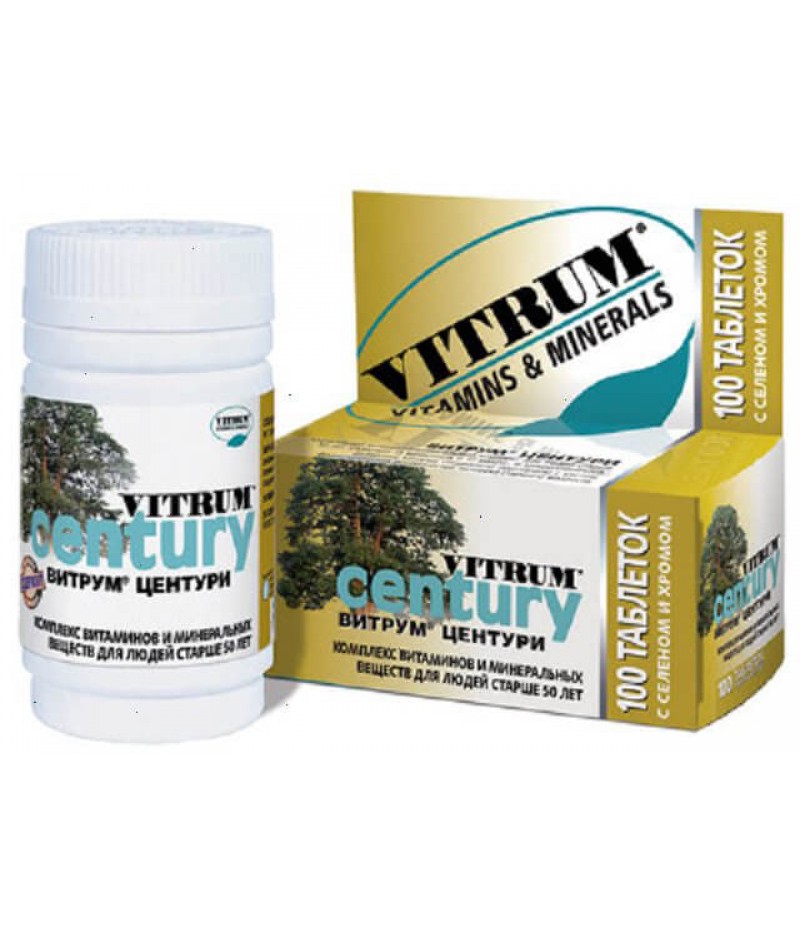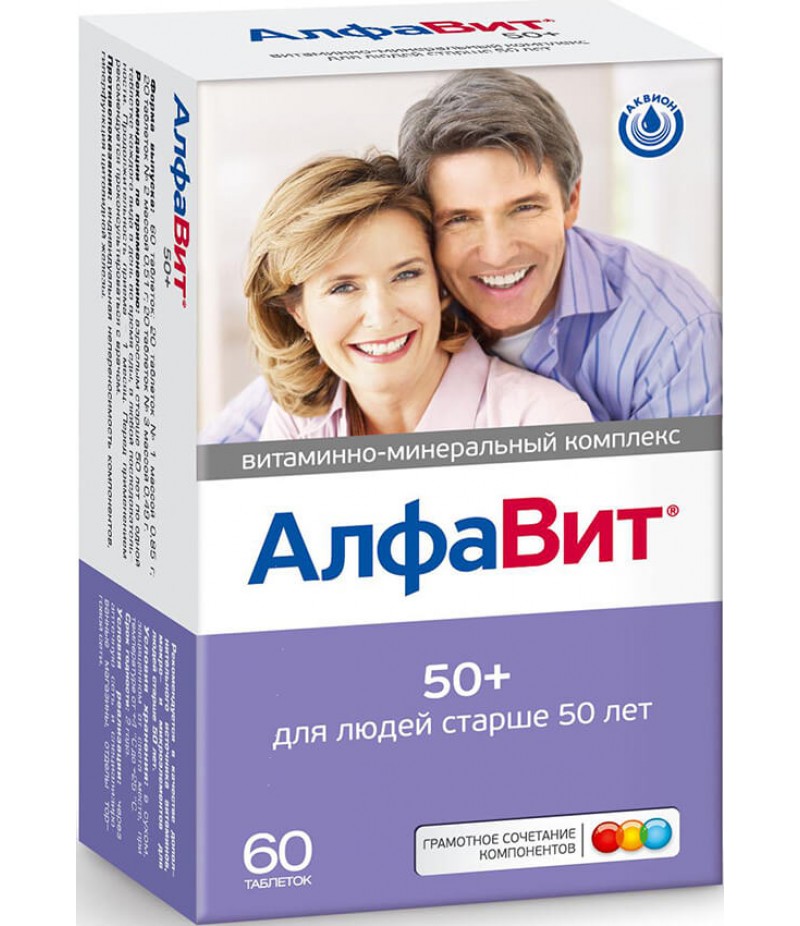Vitrum Century tabs #30
- $31.41
- 3 or more $30.59
- Availability:In Stock
Vitrum Century instructionYou can buy Vitrum Century on this pageCompositionOne tablet contains: acetate retinol (vitamin A) and beta-carotene - 6000 IU (corresponds to the content o
Tags: tabs
Vitrum Century instruction
You can buy Vitrum Century on this page
Composition
One tablet contains:
acetate retinol (vitamin A) and beta-carotene - 6000 IU (corresponds to the content of acetate retinol - 2 mg, betakaren - 112 mcg);
acetate-alfa-tocopherol (vitamin E) -45 IU (45 mg);
phytomenadione (vitamin K1) - 10 μg;
cholecalciferol (vitamin D3) - 400 IU (10 μg);
ascorbic acid (vitamin C) - 60 mg;
thiamine hydrochloride (vitamin B1) - 1.5 mg;
pyridoxine hydrochloride (vitamin B6) - 3 mg;
riboflavin (vitamin B2) - 1.7 mg;
acid pantothenic (in the form of calcium pantothenate - vitamin B5) - 10 mg;
nicotinamide (vitamin PP) - 20 mg;
cyanocobalamin (vitamin B12) - 25 mcg;
folic acid (vitamin B9) - 200 mcg;
calcium (in the form of calcium hydrogenphosphate) - 200 mg;
biotin (vitamin H) - 30 mcg;
magnesium (in the form of magnesium oxide) -100 mg;
Potassium (in the form of potassium chloride) - 80 mg;
phosphorus (in the form of calcium hydrogenphosphate) - 48 mg;
copper (in the form of copper oxide) - 2 mg;
iron (in the form of iron fumarate) - 9 mg;
manganese (in the form of manganese sulfate) - 2.5 mg;
zinc (in the form of zinc oxide) - 15 mg;
iodine (in the form of potassium iodide) - 150 μg;
selenium (in the form of sodium selenate) - 20 mcg;
Boron (in the form of sodium borate) - 150 mcg;
nickel (in the form of nickel sulfate) - 5 μg;
Chromium (as chromium chloride) - 100 μg;
molybdenum (in the form of molybdate sodium) - 25 mcg;
vanadium (in the form of sodium metavanadate) - 10 μg;
chloride (in the form of potassium chloride) - 72 mg;
silicon (in the form of sodium metasilicate) - 10 μg.
The structure of Vitrum Century Forte additionally includes:
tin (in the form of tin chloride) - 5 μg;
lutein - 100 mcg;
leaves of the plant Ginkgo Biloba in powder form - 20 mg.
As auxiliary substances are used: microcrystalline cellulose, stearic acid, colloidal silicon dioxide, croscarmellose sodium, magnesium stearate.
The composition of the shell include: hypromellose, triacetin, titanium dioxide, black dye, yellow dye sunset, red dye charming.
Form of issue
The drug is available in the form of capsular tablets, coated with a film-film of gray color, with a separating strip on the edge; on the side, a straw-colored core, with dark or light inclusions; perhaps the presence of a specific flavor. In polyethylene bottles of 30, 60, 100, 120 or 130 such tablets (for Vitrum Century), in blisters of 30 tablets (for Vitrum Century Forte). One such bottle or 1, 2, 3 such blisters in a cardboard bundle.
pharmachologic effect
Replenishment of lack of vitamins and minerals.
Pharmacodynamics and pharmacokinetics
Vitrum Century refers to a group of drugs called multivitamins or multivitamin preparations. Contains in the composition of all vitamins and minerals in doses required for the elderly after 50 years. Increases the resistance to diseases common at this age, increases physical and mental performance. Reduces the risk of oncological and cardiac diseases, prevents premature aging.
Vitamins A, E, C, beta-carotene, selenium, zinc, copper and manganese are antioxidants and protect cell elements, including chromosomes, from damage by oxygen radicals.
Vitamin A in the elderly is responsible for T- and B-cell immunity, and also promotes the acceleration of the synthesis of cytokines. Retinoic acid supports the activity of killer cells, which play a major role in antiviral and anticancer protection.
Betakarotene is used in the body to build vitamin A molecules, prevents damage to cell membranes by products of lipid peroxidation.
Ascorbic acid - a powerful antioxidant, increases the nonspecific resistance of the body.
Vitamin E is also a strong antioxidant, used in the biosynthesis of hemoglobin and proteins, affects the state of the vessels.
Selenium is converted in the body into glutadione peroxidase, which protects cells and tissues from organic hydroperoxides.
Vitamins B1, B2 and B6 play an important role in the normalization of protein, fat and carbohydrate metabolism.
Vitamin B1 promotes the proper functioning of the biochemical processes of the nervous, endocrine and cardiovascular systems.
Vitamin B2 is a component of flavin enzymes that provide tissue respiration and the formation of ATP molecules in cells, as well as numerous energetically high-cost oxidation-reduction processes.
Vitamin B6 is involved in the metabolism of glycogen, amino acids, sphingoid bases and production of neurotransmitters.
Nicotinamide is an integral part of proteins dehydrogenases that transport hydrogen ions in cells.
Pantothenic acid is involved in the processes of endothelial regeneration and the exchange of fatty acids.
Vitamin B12 is needed for the production of nucleotides and the exchange of fatty acids, the passage of methylation processes in cells. Together with folic acid, it plays an important role in maintaining hematologic and neurological homeostasis.
Folic acid is a coenzyme of molecules responsible for the synthesis and destruction of amino acids and nucleic acids. The use of the necessary amount of folic acid is the prevention of a number of oncological diseases, in particular, cancer of the colon and rectum, lungs, esophagus, stomach.
Vitamin K1 is used to prevent osteoporosis, has anti-sclerotic and anti-inflammatory effect, regulates blood glucose level, improves clinical picture of Alzheimer's disease.
Vitamin D, copper, calcium, magnesium, manganese, zinc and boron play an important role in the prevention of osteoporosis (brittle bones).
Iodine is an important component of thyroid hormones that support the proper functioning of many metabolic processes, maintaining immunity.
Iron is a part of hemoglobin that carries oxygen to organs and tissues and cellular respiration, and many other proteins (myoglobin, flavoproteins, transferrin, lactoferrin, hemosiderin). Improves appetite, stimulates recovery and recovery.
Molybdenum is involved in the construction of molecules of sulfitokinase, xanthoxidase and aldehyde oxidase, responsible for the destruction of some amino acids and heterocyclic bases (purines and pyrimidines). These processes are reflected in the neurological status of the body.
Chromium strengthens the action of insulin.
Nickel in the composition of special proteins regulates the exchange of iron.
Silicon is a building material for bones and collagen.
The Vitrum Century Forte also contains:
lutein - prevents loss of vision and improves its acuity;
the powder of the leaves of the plant Ginkgo Biloba is a proven tool that increases cognitive functions (memory, expense, attention and others) in the elderly;
tin - improves the recovery process, regulates the activity of flavin enzymes, an integral part of the gastrin molecule.
Indications for use
Prevention and treatment of a shortage of vitamins and minerals in the elderly, including:
during mental and physical exertion;
during treatment and rehabilitation of the transferred diseases;
with an unbalanced diet.
Contraindications
Hypersensitivity to the drug and its components; hypercalcemia, hypermagnesia, hypercalciuria, nephrolithiasis, active pulmonary tuberculosis, history of sarcoidosis, hypervitaminosis A, E and D, thrombophlebitis, fructose intolerance, gout, metabolic disorders of copper or iron, severe renal dysfunction, hyperuricemia, erythremia, chronic cardiac insufficiency, thyrotoxicosis , a stomach ulcer or 12 duodenal ulcer (possibly an increase in acidity), joint use of retinoids, selenium.
Side effects
On the part of the immunity system: hypersensitivity reactions are possible, including anaphylaxis, Quincke's edema, fever in people with allergies.
From the skin: rash, hives, redness of the skin, itching.
From the gastrointestinal tract: nausea, dyspeptic disorders, abdominal pain, belching, diarrhea, constipation, increased acidity of gastric juice, heartburn.
From the central nervous system: dizziness, headache, excitability, drowsiness.
With long-term admission in large doses, there may be: irritation of the mucosa of the digestive tract, hypercalcemia, paresthesia, hyperuricemia, hyperglycemia, renal dysfunction, temporary increase in the activity of liver enzymes and alkaline phosphatase, dry skin, seborrhoeic rash, hair loss.
The instruction for Vitrum Century
Instructions for use Vitrum Century Forte does not differ from the instructions for Vitrum Century and prescribes oral intake of 1 tablet a day after meals. The course of treatment with the drug is 3 months. On the appointment of a doctor, repeated courses can be conducted.
Overdose
There are no reports of cases of drug overdose. An overdose of iron is manifested by nausea, diarrhea, abdominal pain, lethargy. Perhaps the emergence of hyperglycemia and acidosis.
Treatment of an overdose: gastric lavage, symptomatic therapy.
Interaction
Since Vitrum Century contains iron and calcium in the corresponding parts of the digestive system, the absorption of antibiotics of the tetracycline group and fluoroquinolones can decrease. Ascorbic acid enhances the effects of sulfonamides. Antacids, including magnesium, aluminum, calcium, reduce the absorption of iron. Preparations of iron and silver reduce the bioavailability of Vitamin E. Folic acid activates the metabolism of phenytoin.
Terms of sale
The drug is dispensed without a prescription.
Storage conditions
Store at temperatures up to 30 degrees in a place inaccessible to children.
Shelf life - 36 months.
special instructions
It is necessary to prescribe with caution the drug for diseases of the liver and kidneys, gastric ulcer or duodenal ulcer in the past, diabetes, cholelithiasis, pancreatitis.
The drug should not be prescribed together with other multivitamin complexes, since an overdose is possible.
Children
Not recommended for use in children.
In pregnancy and lactation
Studies of the effect of the drug in pregnancy and lactation have not been conducted, so you should refrain from taking the drug under these conditions.
Reviews about Vitrum Century
Reviews of vitamins are recorded numerous cases of confirmation of the claimed effect in patients who used Vitrum Century after 50 years.


